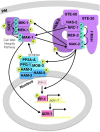Communicate and Fuse: How Filamentous Fungi Establish and Maintain an Interconnected Mycelial Network
- PMID: 31001214
- PMCID: PMC6455062
- DOI: 10.3389/fmicb.2019.00619
Communicate and Fuse: How Filamentous Fungi Establish and Maintain an Interconnected Mycelial Network
Abstract
Cell-to-cell communication and cell fusion are fundamental biological processes across the tree of life. Survival is often dependent upon being able to identify nearby individuals and respond appropriately. Communication between genetically different individuals allows for the identification of potential mating partners, symbionts, prey, or predators. In contrast, communication between genetically similar (or identical) individuals is important for mediating the development of multicellular organisms or for coordinating density-dependent behaviors (i.e., quorum sensing). This review describes the molecular and genetic mechanisms that mediate cell-to-cell communication and cell fusion between cells of Ascomycete filamentous fungi, with a focus on Neurospora crassa. Filamentous fungi exist as a multicellular, multinuclear network of hyphae, and communication-mediated cell fusion is an important aspect of colony development at each stage of the life cycle. Asexual spore germination occurs in a density-dependent manner. Germinated spores (germlings) avoid cells that are genetically different at specific loci, while chemotropically engaging with cells that share identity at these recognition loci. Germlings with genetic identity at recognition loci undergo cell fusion when in close proximity, a fitness attribute that contributes to more rapid colony establishment. Communication and cell fusion also occur between hyphae in a colony, which are important for reinforcing colony architecture and supporting the development of complex structures such as aerial hyphae and sexual reproductive structures. Over 70 genes have been identified in filamentous fungi (primarily N. crassa) that are involved in kind recognition, chemotropic interactions, and cell fusion. While the hypothetical signal(s) and receptor(s) remain to be described, a dynamic molecular signaling network that regulates cell-cell interactions has been revealed, including two conserved MAP-Kinase cascades, a conserved STRIPAK complex, transcription factors, a NOX complex involved in the generation of reactive oxygen species, cell-integrity sensors, actin, components of the secretory pathway, and several other proteins. Together these pathways facilitate the integration of extracellular signals, direct polarized growth, and initiate a transcriptional program that reinforces signaling and prepares cells for downstream processes, such as membrane merger, cell fusion and adaptation to heterokaryon formation.
Keywords: MAP kinase signaling; Neurospora; ROS signaling; STRIPAK; cell fusion; chemotropic interactions.
Figures



Similar articles
-
Integration of Self and Non-self Recognition Modulates Asexual Cell-to-Cell Communication in Neurospora crassa.Genetics. 2019 Apr;211(4):1255-1267. doi: 10.1534/genetics.118.301780. Epub 2019 Feb 4. Genetics. 2019. PMID: 30718271 Free PMC article.
-
Early colony establishment in Neurospora crassa requires a MAP kinase regulatory network.Genetics. 2013 Nov;195(3):883-98. doi: 10.1534/genetics.113.156984. Epub 2013 Sep 13. Genetics. 2013. PMID: 24037267 Free PMC article.
-
The Predicted Mannosyltransferase GT69-2 Antagonizes RFW-1 To Regulate Cell Fusion in Neurospora crassa.mBio. 2021 Mar 16;12(2):e00307-21. doi: 10.1128/mBio.00307-21. mBio. 2021. PMID: 33727349 Free PMC article.
-
Signal exchange and integration during self-fusion in filamentous fungi.Semin Cell Dev Biol. 2016 Sep;57:76-83. doi: 10.1016/j.semcdb.2016.03.016. Epub 2016 Mar 23. Semin Cell Dev Biol. 2016. PMID: 27032478 Review.
-
Cell fusion in the filamentous fungus, Neurospora crassa.Methods Mol Biol. 2008;475:21-38. doi: 10.1007/978-1-59745-250-2_2. Methods Mol Biol. 2008. PMID: 18979236 Review.
Cited by
-
AoRan1 Is Involved in Regulating Conidiation, Stress Resistance, Secondary Metabolism, and Pathogenicity in Arthrobotrys oligospora.Microorganisms. 2024 Sep 6;12(9):1853. doi: 10.3390/microorganisms12091853. Microorganisms. 2024. PMID: 39338527 Free PMC article.
-
Network traits predict ecological strategies in fungi.ISME Commun. 2022 Jan 5;2(1):2. doi: 10.1038/s43705-021-00085-1. ISME Commun. 2022. PMID: 37938271 Free PMC article.
-
Antibody screening reveals antigenic proteins involved in Talaromyces marneffei and human interaction.Front Cell Infect Microbiol. 2023 Jun 19;13:1118979. doi: 10.3389/fcimb.2023.1118979. eCollection 2023. Front Cell Infect Microbiol. 2023. PMID: 37404721 Free PMC article.
-
Special Issue "Signal Transductions in Fungi".J Fungi (Basel). 2022 May 20;8(5):528. doi: 10.3390/jof8050528. J Fungi (Basel). 2022. PMID: 35628783 Free PMC article.
-
The Conserved Serine Transporter SdaC Moonlights To Enable Self Recognition.J Bacteriol. 2022 Jan 18;204(1):e0034721. doi: 10.1128/JB.00347-21. Epub 2021 Oct 18. J Bacteriol. 2022. PMID: 34662238 Free PMC article.
References
Publication types
LinkOut - more resources
Full Text Sources
Other Literature Sources

